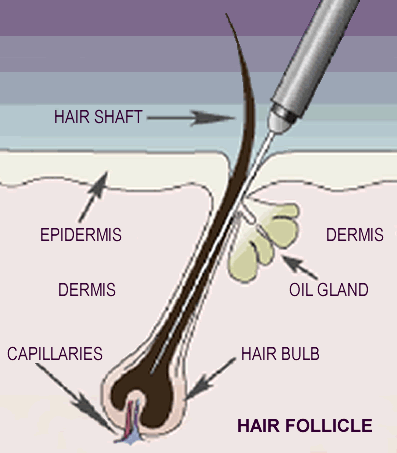Electrolysis Education

What Is Electrolysis?
Electrolysis is a safe & permanent method of hair removal. Electrolysis can be applied to most facial and body areas and is effective on all skin and hair types. . Laser hair removal is hair REDUCTION and is NOT PERMANENT.
Electrolysis is the only FDA and medically proven method of permanent hair removal.
Electrolysis is a procedure that is performed by inserting a thin sterilized filament into the hair follicle & a tap on a foot pedal sends a short current of heat into the follicle cauterizing the papilla (ie root) causing the blood flow to the root to diminish. The blood supply to the papilla is diminished with each treatment and subsequently grows back finer. Eventually, the blood supply is completely destroyed and the follicle can't produce hair again. For a number of different reasons, certain hairs may require more than one treatment. It is not uncommon for treatments to last over a period of time in order to permanently remove unwanted hair. PCOS, testosterone levels, hirsutism, tweezing, waxing, threading, menopause, hysterectomies and the cycle of hair determine how many treatments are needed.
Where Electrolysis Is Effective?
Electrolysis is effective on EVERYONE and all areas where hair grows. No matter the color or texture of hair.
A further explanation of obstacles an Electrologist faces in attempting to eliminate hairs are as follows:
Re Growth:
A certain percentage of hairs treated with electrolysis will grow back finer in texture. A distorted, deep, curved follicle & coarse or curly hairs are more difficult to eliminate and a number of treatments will be needed to effectively destroy the papilla.
Hair Cycles:
Hairs grow in 3 cycles (anagen, catagen & telogen). Hairs are more easily damaged in the anagen stage and less likely in the telogen stage because the hair needs to be connected to the root. This is why it's important to stay constant with your treatment schedule.
Distorted Hair Follicles:
Some hairs may be twisted or curved underneath the surface of the skin. These hairs are more difficult to remove because the heat can’t come into direct contact with the papilla, therefore they usually require multiple treatments but can still be successfully treated over time.
Maintenance between treatments:
You may shave, cut or use depilatories, but we DON'T recommend tweezing, waxing, threading or any method that pulls the hair out by the root. When you tweeze or wax, this forcibly rips the root from the papilla. The body know it has been injured & sends more blood to the area to over heal and causes follicle distortion, skin discoloration and ingrown hairs. It's part of our bodies defense system to not let that trauma happen again.
Why multiple treatments are needed:
Not all of the hair you have is present at any one given time. Hair grows in cycles and the hairs that are visible during the time of your treatment aren't all the hairs you have. The hairs that you see within 7 days aren't the same hairs that were treated when you came the prior time. Those are hairs that weren't out at the time of your visit. Remember, the hairs that you SEE, are NOT all the hairs that you have. It takes 4 to 6 weeks for a hair to reform & grow. This is why you MUST stay on schedule with your appointments to make sure that all hairs get treated and damaged.
How long does the hair need to be?
We must be able to grab the hair with tweezers to be able to successfully treat the hair. Also, we must be able to see which direction the hairs are growing to enter the follicle correctly. If the hairs are too long, it slows down the process so I recommend shaving 3 to 5 days prior to your appointment.
How long does it take for the hair to be removed permanently?
This is by far the most common question asked. The duration of Electrolysis varies significantly with each individual. The general answer is 18 months to 3 years. Many factors will determine treatment length, which are the amount of hair, texture, gender, prior hair removal regiments, hormones, medications, age, hair structure, etc. An Electrologist can NOT predict how long it will honestly take. Before you realize it, your treatment times will become shorter in time and further apart until it's over.
What should you do to prepare for treatment:
We suggest that you stay hydrated. You should be drinking half your body weight in ounces of water. Do not go on a drinking binge the night before because alcohol is very dehydrating. Do not have any caffeine the day of your treatment because it heightens the pain level. Also get plenty of rest the night prior to your appointment. You may drink as much as you want afterwards.
Does it hurt?
Tolerance levels vary from person to person. Most people feel a mild stinging sensation that lasts 1/1000th of a second and some don't even notice. Actually most fall asleep during sessions. Also, it's contingent on what area is being treated but most tolerate the sensation and feel practically nothing. There are numbing creams such as Lidocaine that you can apply 1hr prior to take the edge off but most don't need it. I'm not allowed by law to administer it but you can do it yourself.
Aftercare:
Depending on how long your treatment is, you will experience some swelling and redness which is normally gone within 2 hours. We recommend that you stay out of the direct sun, no excessive sweating, no wearing of makeup and no touching of the area until the next morning. We will cleanse the area after your session and properly apply Hydrogel to sooth and help bring the skin back to its normal PH.


